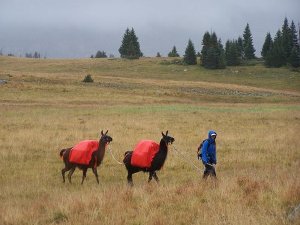Physical Characteristics
of the Llama
 The llama is an ungulate adapted to high altitude
environments. The height of a mature llama will average
5-6’ at the poll. Height at the withers (shoulder
blades) will average 43-50” and the body weight of
a physically fit llama will range between 250 and 400#.
Females will add up to 70 pounds to their basal weight
during pregnancy. The llama hoof is cloven, padded, and
has a large surface area in relation to body weight. The
animals walk with a rolling gait (pacing) and have a
unique leg structure. Their pasterns are not erect and
quite flexible while their fetlocks are erect, but still
quite flexible. The llamas’ conformation is
slightly forward sloping and they bear 65% of their
weight on the front limbs which naturally have a slight
toe-out for balance. The back legs are structured for a
long throw to provide the primary propulsion for their
various gaits. There are latent scent glands typically
located on the back legs (canon bone) that are of a
tissue similar to the tissue in horse chestnuts. They
serve no obvious purpose. Llamas use a three part rocking
motion common to the camel when they lie down and arise.
They are athletic, agile, and quite strong and possess
speed, quickness, and impressive jumping ability. Their
primary natural protection is flight and evasion.
The llama is an ungulate adapted to high altitude
environments. The height of a mature llama will average
5-6’ at the poll. Height at the withers (shoulder
blades) will average 43-50” and the body weight of
a physically fit llama will range between 250 and 400#.
Females will add up to 70 pounds to their basal weight
during pregnancy. The llama hoof is cloven, padded, and
has a large surface area in relation to body weight. The
animals walk with a rolling gait (pacing) and have a
unique leg structure. Their pasterns are not erect and
quite flexible while their fetlocks are erect, but still
quite flexible. The llamas’ conformation is
slightly forward sloping and they bear 65% of their
weight on the front limbs which naturally have a slight
toe-out for balance. The back legs are structured for a
long throw to provide the primary propulsion for their
various gaits. There are latent scent glands typically
located on the back legs (canon bone) that are of a
tissue similar to the tissue in horse chestnuts. They
serve no obvious purpose. Llamas use a three part rocking
motion common to the camel when they lie down and arise.
They are athletic, agile, and quite strong and possess
speed, quickness, and impressive jumping ability. Their
primary natural protection is flight and evasion.
Llamas are covered with a double coat of fiber that consists of a dense under fleece of fine (5-20+ microns) and a second protective coat of guard hair which is longer and grows through the downy under layer. This hair is rather coarse (30-70 microns) and stiff and serves as protection from abrasion, debris, and weather. The underlayer matures and sheds every 2 years. The underbelly, inside of the legs, and face are covered with a short hair that is important in protection and temperature regulation. Llama fiber is hollow yet has a high tensile strength. As the diameter of the llama fiber increases, the percentage of hollow space also increases. The fiber is dry and has no lanolin. Llamas establish dusting bowls on the driest areas of their pastures/territories to roll in to condition and maintain the loft of their fleece. The fiber occurs in various natural earth tone colors as well as many unique patterns, both solid and broken.
Two large, doelike eyes located on each side of the llama’s head near the top of the face provide excellent visual acuity. They have two ears that are long, erect, and gracefully curved. The ears are located on either side of the poll and can be positioned from erect to rotated backward 90+ degrees. Ear positioning is used to maximize sound gathering as well as to communicate territorial tensions. Hearing is highly developed and important to their survival.
Llamas have a long, refined face with large nostrils set over the mouth at the terminus. The nostrils serve a sensitive olfactory system that’s important to the interpretaion of their surrounding environment. The mouth is marked by a cleft upper lip that is prehensile and adapted to browsing fine or small vegetation. Their dentition is similar to other ruminants with an upper front grazing palate matching against incisors on the bottom arcade of the lower mandible and a full set of molars for mastication on the rear arcades, top and bottom. Additionally, they have six ruminant canines at the front of the mouth. Each side has 2 canines emerging from the upper palate and one from the lower jaw that is positioned between the upper two when the lower jaw is closed. These teeth are sharp and prominent in males and are a significant presence in territorial battles and should be cut for safe management of confined llamas. The teeth are vestigial and of little significance in the females.
There is no specific nomenclature for camelids denoting sex or age as there is in other ungulates, both wild and domestic. They are basically male llamas, female llamas, and babies. Some adaptation has occurred here in the US. Brood females (mature breeding females), studs (mature breeding males), geldings (castrated males), and crias (babies) are some terms commonly applied.
